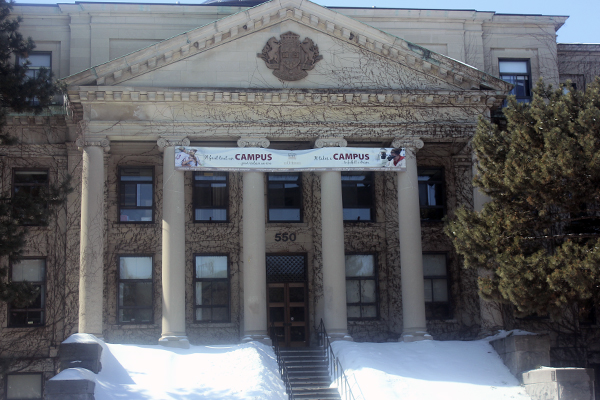New information reveals one of Canada’s most well-kept secrets at Tabaret Hall
Photo by Tina Wallace
University of Ottawa students are used to seeing their school’s logo draped on buildings, signs, and of course, hoodies. It has always seemed pretty innocent, just a normal logo displaying the front façade of the iconic Tabaret Hall, right?
Little do they know that this logo was a symbol of an ancient society.
The clues are right in front of students’ eyes. There are five pillars on Tabaret in the logo, while on the building itself there are six. What happened to the sixth pillar?
This question has eaten away at some for decades, but the Tomato has recently come across new information that reveals one of the best-kept secrets in Canadian history.
Since its erection in 1905, Tabaret Hall has long been the focal point and prized gem of the U of O’s campus. A breathtaking building anchored by its majestic pillars, it is often used for advertisements and events in order to sell the university. So why would such an iconic symbol be misrepresented in the school’s logo by missing one pillar. Human error? Negligence?
After a closer examination, one can tell that the furthest right pillar is the one unrepresented in the logo and steeped in mystery. After the Tomato recovered old building records and blueprints from a source inside Tabaret, we learned that the sixth pillar was never documented or even planned. Yet, it still clearly appears on the outside of the building.
The Tomato contacted the university’s information office and asked how many pillars were at the front of Tabaret. The question drew a response of heavy breathing from the previously cheerful secretary, before he quickly answered “five” and hung up.
But that didn’t stop us. We took the question higher, right to the president’s office. During a planned monthly meeting with Allan Rock, we asked him if he knew any information about the sixth pillar. A look of cold fear struck his face as he vigorously declined to officially comment before whispering the words “ask Trebek” as he stormed out of his own office in Tabaret.
The next stop on this journey for the truth took us to Culver City, Calif. at the studio where the famed game show Jeopardy! is filmed. As most know, Jeopardy’s long-time host is the beloved Alex Trebek, whose alma mater is the U of O. We asked Trebek about the mystery of the sixth pillar and who or what was behind it. He was very hesitant to cooperate at first and made for the exit, but this time we had it blocked. He finally mustered up the courage to answer, “What is: the Sixth Pillar Society.”
After rigorous Google searches, nothing could be found about this secret society, until a trip to the Parliamentary Library finally cracked the mystery. Nestled away in the prime minister’s private section, between pristine copies of Raggedy Ann & Andy books and the 50 Shades of Grey series, we found the book that contained all the secrets of the mysterious Sixth Pillar Society. Inside were the blueprints that detailed the secret clubhouse built in the sixth pillar that has housed some of the most elite and famous members of Canada’s past. We found photos of Sir John A. Macdonald, Sir Wilfrid Laurier, Frederick Banting, Alex Trebek, Steve Nash, Keanu Reeves, Drake, and Ben Mulroney all within the mysterious pillar — although to be fair there were reports that both Reeves and Mulroney had snuck their way in.
Little did the innocent students of the U of O know that their university had been hiding a secret society in plain sight for more than a century. After learning the full extent of the club, the Tomato approached Rock once again for a comment, but still he refused, citing the 16 separate times he had been refused entrance to the society as his reason.
For many, this will simply be remembered as the basis for the upcoming third National Treasure movie starring Nicolas Cage. But for others who have spent their lives searching for answers about the sixth pillar, this is justice.
The Tomato is the Fulcrum’s satirical news page within the opinions section. These articles are meant to satirize an issue in our community or nation. They are not to be taken seriously; however, you should consider them in relation to your other news sources.





